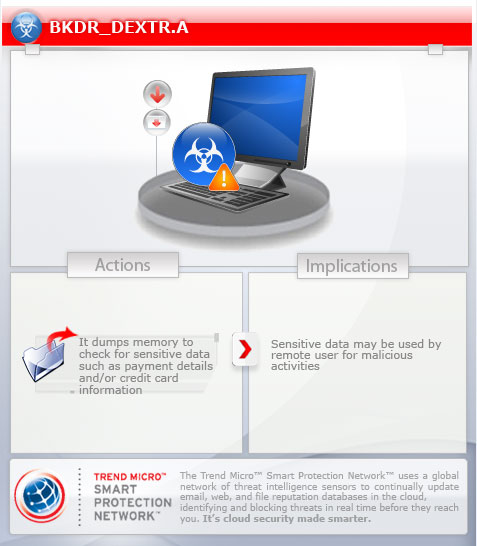BKDR_DEXTR.A
Windows 2000, Windows Server 2003, Windows XP (32-bit, 64-bit), Windows Vista (32-bit, 64-bit), Windows 7 (32-bit, 64-bit)


Threat Type: Backdoor
Destructiveness: No
Encrypted: Yes
In the wild: Yes
OVERVIEW
Downloaded from the Internet, Dropped by other malware
This malware was discovered to target point of sale (POS) systems used in establishments such as restaurants and hotels in order to steal credit card information from purchasing customers. Purchasing from the establishments with infected systems may result in users' financial information being stolen, and may find themselves billed with unauthorized expenses made by cybercriminals.
To get a one-glance comprehensive view of the behavior of this Backdoor, refer to the Threat Diagram shown below.

For the related story, you may read the blog post Infostealer Dexter Targets Checkout Systems
This backdoor is also known as BlackPOS.
This backdoor arrives on a system as a file dropped by other malware or as a file downloaded unknowingly by users when visiting malicious sites.
It runs certain commands that it receives remotely from a malicious user. Doing this puts the affected computer and information found on the computer at greater risk.
TECHNICAL DETAILS
51,200 bytes
EXE
Yes
13 Dec 2012
Steals information, Connects to URLs/IPs
Arrival Details
This backdoor arrives on a system as a file dropped by other malware or as a file downloaded unknowingly by users when visiting malicious sites.
Installation
This backdoor drops the following copies of itself into the affected system:
- %Application Data%\{random}\{random}.exe
(Note: %Application Data% is the current user's Application Data folder, which is usually C:\Documents and Settings\{user name}\Application Data on Windows 2000, XP, and Server 2003, or C:\Users\{user name}\AppData\Roaming on Windows Vista and 7.)
It adds the following processes:
- iexplore.exe
It creates the following folders:
- %Application Data%\{random}
(Note: %Application Data% is the current user's Application Data folder, which is usually C:\Documents and Settings\{user name}\Application Data on Windows 2000, XP, and Server 2003, or C:\Users\{user name}\AppData\Roaming on Windows Vista and 7.)
It adds the following mutexes to ensure that only one of its copies runs at any one time:
- WindowsResilienceServiceMutex
It injects itself into the following processes as part of its memory residency routine:
- iexplore.exe
Autostart Technique
This backdoor adds the following registry entries to enable its automatic execution at every system startup:
HKEY_CURRENT_USER\Software\Microsoft\
Windows\CurrentVersion\Run
{GUID} = "%Application Data%\{random}\{random}.exe"
HKEY_CURRENT_USER\Software\Microsoft\
Windows\CurrentVersion\Run
{GUID} = "%Application Data%\{random}\{random}.exe"
Other System Modifications
This backdoor adds the following registry entries as part of its installation routine:
HKEY_CURRENT_USER\Software\Resilience Software
Digit = "{GUID}"
HKEY_CURRENT_USER\Software\Microsoft\
Windows\CurrentVersion\Policies\
Associations
LowRiskFileTypes = ".exe;.bat;.reg;.vbs;"
It adds the following registry keys as part of its installation routine:
HKEY_CURRENT_USER\Software\Resilience Software
HKEY_CURRENT_USER\Software\Microsoft\
Windows\CurrentVersion\Policies\
Associations
Backdoor Routine
This backdoor executes the following command(s) from a remote malicious user:
- Update (update copy)
- Checkin (set the delay it sends information)
- Scanin (set the delay it checks memory for information)
- Uninstall (uninstall itself)
- Download (download and execute a file)
Information Theft
This backdoor gathers the following data:
- {GUID}
- Username
- Hostname
- Operating System
- Processor type
- List of running processes
- Key to decrypt sent information
Stolen Information
This backdoor sends the gathered information via HTTP POST to the following URL:
- http://{BLOCKED}.com/portal1/gateway.php
- http://{BLOCKED}.17.126/test/gateway.php
NOTES:
This backdoor dumps the affected system's memory to check for sensitive information, such as payment details and/or credit card information stored in the aforementioned system.
SOLUTION
9.300
9.590.07
13 Dec 2012
9.591.00
13 Dec 2012
Step 1
Before doing any scans, Windows XP, Windows Vista, and Windows 7 users must disable System Restore to allow full scanning of their computers.
Step 2
Restart in Safe Mode
Step 3
Delete this registry key
Important: Editing the Windows Registry incorrectly can lead to irreversible system malfunction. Please do this step only if you know how or you can ask assistance from your system administrator. Else, check this Microsoft article first before modifying your computer's registry. Before you could do this, you must restart in Safe Mode. For instructions on how to do this, you may refer to this page If the preceding step requires you to restart in safe mode, you may proceed to edit the system registry.
- In HKEY_CURRENT_USER\Software
- Resilience Software
- Resilience Software
- In HKEY_CURRENT_USER\Software\Microsoft\Windows\CurrentVersion\Policies
- Associations
- Associations
Step 4
Delete this registry value
Important: Editing the Windows Registry incorrectly can lead to irreversible system malfunction. Please do this step only if you know how or you can ask assistance from your system administrator. Else, check this Microsoft article first before modifying your computer's registry.
- In HKEY_LOCAL_MACHINE\SOFTWARE\Microsoft\Windows\CurrentVersion\Run
- {GUID} = "%Application Data%\{random}\{random}.exe"
- {GUID} = "%Application Data%\{random}\{random}.exe"
- In HKEY_CURRENT_USER\Software\Microsoft\Windows\CurrentVersion\Run
- {GUID} = "%Application Data%\{random}\{random}.exe"
- {GUID} = "%Application Data%\{random}\{random}.exe"
Step 5
Search and delete this folder
- %Application Data%\{random}
Step 6
Restart in normal mode and scan your computer with your Trend Micro product for files detected as BKDR_DEXTR.A. If the detected files have already been cleaned, deleted, or quarantined by your Trend Micro product, no further step is required. You may opt to simply delete the quarantined files. Please check this Knowledge Base page for more information.
Did this description help? Tell us how we did.


